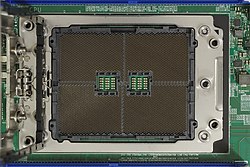
Back Sockel SP3 German Socket SP3 Spanish Socket SP3 French Socket SP3 Japanese 소켓 SP3 Korean Socket SP3 Polish Soquete SP3 Portuguese Socket SP3 Ukrainian Socket SP3 Chinese
 | |
| Release date | June 20, 2017 |
|---|---|
| Designed by | AMD |
| Manufactured by |
|
| Type | LGA-ZIF |
| Chip form factors | Flip-chip |
| Contacts | 4094 |
| FSB protocol | PCI Express, Infinity Fabric |
| Voltage range | 1.8V (Threadripper) 1.3V (EPYC) |
| Processor dimensions | 58.5mm x 75.4mm 4410.9 mm2 |
| Processors | Epyc: |
| Predecessor | |
| Successor | |
| Memory support | ECC DDR4 |
This article is part of the CPU socket series | |

Socket SP3 is a zero insertion force land grid array CPU socket designed by AMD supporting its Zen-, Zen 2- and Zen 3-based Epyc server processors,[1][2] launched on June 20, 2017.[3] Because the socket is physically the same size as socket TR4 and socket sTRX4, users can use CPU coolers not only designed for SP3, but also coolers designed for TR4 and sTRX4.
Socket SP3 is a system in a package socket - that means most features required to make the system fully functional (such as memory, PCI Express, SATA controllers etc.) are fully integrated into the processor package, eliminating the need for a chipset to be placed on a motherboard. Variants for desktop platforms (as said below) are, eventually, requiring an additional chipset to unlock the functionality of the CPU. A processor using socket SP3 is mounted by inserting the CPU into a slide and fixing the slide assembly by tightening three screws using the torque wrenches normally provided alongside the motherboard. Automated processor mounting tools in OEMs do not use the slide, instead relying upon the precision movement of the robot arm.
- ^ Ung, Gordon (May 30, 2017). "AMD's 'TR4' Threadripper CPU socket is gigantic". PCWorld. Retrieved November 16, 2022.
- ^ Campbell, Mark (May 29, 2017). "Noctua showcase EPYC/Threadripper Ready TR4/SP3 ready CPU coolers". Overclock3D. Retrieved November 16, 2022.
- ^ Smith, Ryan (May 30, 2017). "Home>CPUs AMD CPU Updates: 16 Core ThreadRipper w/64 PCIe Lanes This Summer, Epyc Launching June 20th". AnandTech. Retrieved November 16, 2022.